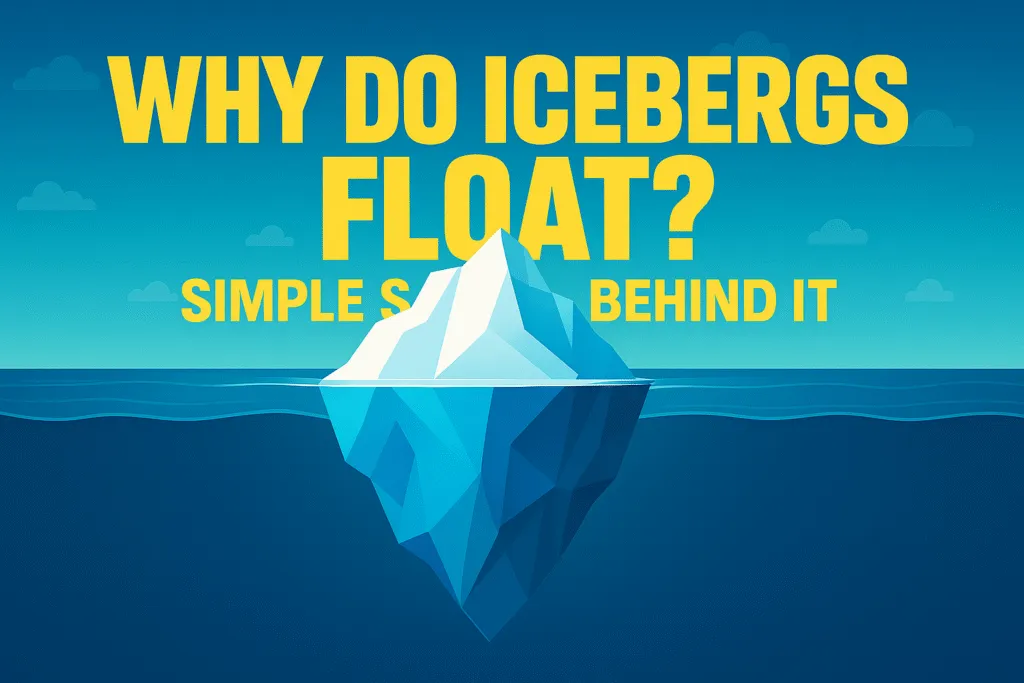Introduction
Have you ever wondered why icebergs float even though they are massive blocks of ice? It’s one of nature’s most fascinating phenomena and a perfect example of science at work in our everyday world. Icebergs, which break off from glaciers and drift in oceans, are made entirely of frozen freshwater. Yet despite their enormous weight, they manage to float effortlessly in saltwater.
Understanding why icebergs float helps us appreciate the delicate balance between water, ice, and density. While it might seem like magic, it all comes down to a few basic principles of physics. When ice freezes, its molecular structure expands, making it less dense than liquid water. This lower density is the key reason behind the floating behavior of icebergs.
Interestingly, about 90% of an iceberg remains underwater, with only the tip visible above the surface. This “tip of the iceberg” expression we often use in daily conversation actually comes from this scientific truth. What we see is only a small part of the whole, and there’s much more hidden beneath.
In this blog, we’ll break down the science behind floating icebergs in a simple, engaging way. From understanding density to learning how saltwater plays a role, this topic combines curiosity with easy-to-grasp science. Whether you’re a student, teacher, or just someone who loves interesting facts, learning why icebergs float is a journey worth taking.
What Is an Iceberg Made Of?
An iceberg may look like a giant block of ice drifting in the ocean, but there’s more to it than meets the eye. At its core, an iceberg is made of compacted freshwater ice that originates from glaciers or snow-packed regions. Over time, layers of snow accumulate, compress, and transform into dense ice, which eventually breaks off and becomes what we call an iceberg.
Unlike sea ice, which forms directly from the freezing of ocean water, icebergs are formed on land and then make their way to the ocean. This difference in origin also explains why icebergs float more easily in saltwater. Since freshwater ice is less dense than salty ocean water, icebergs float despite their massive size.
Besides ice, icebergs can sometimes contain trapped air bubbles, small amounts of rock debris, or sediment picked up during their glacier journey. These additions don’t significantly affect their buoyancy but do influence their appearance. Some icebergs may appear white due to the reflection of light on air bubbles, while others can have a blue tint if the ice is denser and free of air.
Understanding what icebergs are made of helps us grasp why icebergs float and behave the way they do in the ocean. Their unique composition and formation process make them more than just frozen blocks—they’re floating archives of Earth’s natural history. So next time you spot a picture of an iceberg, remember: it’s not just ice; it’s a story frozen in time. Understanding the importance of icebergs and their role in climate helps us appreciate how these frozen giants impact Earth’s natural systems.
Basic Science of Floating Objects
To understand why icebergs float, we first need to explore the basic science of how floating works. Whether it’s a leaf on water or a massive ship at sea, everything that floats obeys the same principle—buoyancy. This concept was first explained by the ancient Greek scientist Archimedes, and it still holds true today.
Archimedes’ Principle states that when an object is placed in a fluid, it experiences an upward force equal to the weight of the fluid it displaces. This force is what we call buoyancy. If the upward force is greater than the object’s weight, the object will float. If not, it will sink.
In simpler terms, if something is less dense than the fluid it’s in, it floats. Density is the amount of mass packed into a certain volume. So, an object with lower density than water will float on its surface. This is exactly what happens with icebergs.
Even though icebergs are huge and heavy, the ice they are made of is actually less dense than liquid water. That’s why icebergs float, with a large portion hidden below the surface and just the tip visible above. It’s a perfect real-world example of buoyancy and density in action.
The basic science of floating objects applies to everything from rubber ducks in a bathtub to glaciers drifting across the ocean. Understanding these principles makes it easier to see why icebergs float despite their size—and it also shows just how elegant and consistent the laws of physics really are.
Why Ice Is Less Dense Than Water
One of the main reasons icebergs float is because ice is less dense than liquid water. While that might sound odd at first—since most solids are denser than their liquid forms—water behaves differently due to its unique molecular structure.
When water freezes, its molecules arrange themselves in a rigid, open hexagonal pattern. This structure is held together by hydrogen bonds and creates more space between the molecules compared to when they are in liquid form. As a result, the same volume of ice weighs less than the same volume of liquid water. In scientific terms, this means ice has a lower density.
This lower density explains why icebergs float in the ocean. As the frozen freshwater ice moves into saltwater, the denser liquid supports the lighter solid, causing it to rise and stay afloat. In fact, this is why about 90% of an iceberg stays hidden below the surface, while only 10% is visible above water. The reason ice floats is explained well by why does ice float, highlighting the role of density and molecular structure.
The fact that ice is less dense than water isn’t just important for floating icebergs—it’s crucial for life on Earth. If ice were denser than water, it would sink to the bottom of lakes and oceans, freezing everything from the ground up. Instead, floating ice insulates the water below, helping aquatic life survive in cold climates.
So, the next time you see ice floating in a glass or think about icebergs drifting in the sea, remember: the reason icebergs float lies in the surprising way water molecules behave when they freeze. It’s a small detail with a massive impact on our planet.
How Much of an Iceberg Floats Above Water?
You’ve probably heard the phrase “just the tip of the iceberg”—and it’s not just a saying. In reality, only about 10% of an iceberg floats above the surface of the water, while a whopping 90% remains hidden beneath. This incredible fact shows just how much more there is beneath the surface than what we can see.
The reason for this lies in the difference in density between ice and saltwater. Icebergs are made of freshwater ice, which is less dense than the salty ocean water they float in. When an object is placed in a fluid, it displaces an amount of fluid equal to its own weight. Since ice is only slightly less dense than seawater, it doesn’t rise all the way to the top—it floats with most of its mass submerged.
This balance between weight and displacement is what allows icebergs to remain stable in the ocean. However, their hidden bulk also makes them dangerous to ships, as the underwater portion can stretch far wider than the visible tip. This is exactly what made the Titanic’s iceberg encounter so deadly—what was above water looked small, but the real threat was hidden below.
Knowing how much of an iceberg floats above water helps us better understand how buoyancy works and why icebergs float at all. It’s a powerful reminder that sometimes the most important parts of a thing are the ones you can’t immediately see. In nature, as in life, there’s often more beneath the surface than meets the eye.
Saltwater vs. Freshwater: A Density Comparison
To fully understand why icebergs float, it’s important to look at the difference between saltwater and freshwater in terms of density. Density is a measure of how much mass is packed into a certain volume. The more particles in a space, the denser the substance is.
Saltwater is denser than freshwater because it contains dissolved salts and minerals. These added particles increase the mass without increasing the volume by much, making saltwater heavier per unit of volume. This higher density is exactly what helps icebergs float better in the ocean than they would in a freshwater lake.
Icebergs are made of frozen freshwater, which is less dense than both freshwater and saltwater in their liquid forms. When a freshwater iceberg enters saltwater, it displaces a volume of water equal to its weight. Since saltwater is denser, it provides more buoyant force to support the iceberg, allowing it to float more efficiently.
If icebergs were placed in a giant body of freshwater, they would still float, but slightly deeper, because freshwater provides less upward force than saltwater. This simple density difference plays a major role in oceanic behavior and iceberg stability.
This comparison also highlights why understanding fluid density is key in marine science, ship design, and even climate studies. Knowing how saltwater and freshwater interact helps scientists predict iceberg drift, melting patterns, and their impact on global sea levels.
So, the reason icebergs float the way they do is not just about the ice—they owe their position to the dense, salty ocean supporting them from below.
Do All Types of Ice Float?
We know that icebergs float because ice is less dense than water, but does that apply to all types of ice? The short answer is: mostly yes, but with a few interesting exceptions.
Most common types of ice, including the ice cubes in your drink and the freshwater ice found in icebergs, do float in water. This is because of the way water molecules arrange themselves when they freeze. As water turns to ice, the molecules spread out into a structured pattern that takes up more space, reducing the overall density. This expanded structure is why ice is lighter than liquid water and why icebergs float.
However, ice isn’t always the same. Scientists have discovered more than a dozen different types of ice, known as ice polymorphs, each with a unique molecular structure. These forms of ice occur under different conditions of temperature and pressure. Some of them, like Ice II or Ice VI, are much denser than the ice we see on Earth’s surface and can actually sink in water if created in the right lab conditions.
That said, these dense forms of ice don’t form naturally on Earth’s surface. You won’t see them in oceans, lakes, or even glaciers. They’re mainly found deep inside icy planets or moons, where the pressure is extreme.
In our everyday world, nearly all ice types we encounter—including icebergs—will float because they are made of normal, low-density ice. This floating ability is what makes icebergs so visible in oceans and also so important in maintaining Earth’s climate balance.
So while not every type of ice floats, the kind that makes up icebergs definitely does—and that’s what keeps these giant frozen structures drifting across our oceans.
What Happens When Icebergs Melt?
Icebergs are majestic and powerful, but like all ice, they eventually melt. So what really happens when icebergs melt into the ocean—and should we be worried about it?
When icebergs melt, they release freshwater back into the sea. Since they are already floating, their melting doesn’t directly raise sea levels. This follows the principle of displacement: a floating object displaces its own weight in water. As a result, the melting of icebergs has little to no effect on global sea levels by itself.
However, there’s more to the story. Icebergs are formed from glaciers, which are part of the larger ice sheets on land. When these glaciers break off and fall into the ocean, becoming icebergs, they represent land-based ice entering the sea. It’s this process—called calving—that contributes to rising sea levels. Once the iceberg melts, it adds to the ocean’s total water volume.
The melting of icebergs also affects ocean salinity. Since icebergs are made of freshwater, their meltwater can slightly reduce the salt concentration in surrounding seawater. In regions like the North Atlantic, this can disrupt ocean currents, which rely on a balance of temperature and salinity to function properly.
Additionally, melting icebergs can have ecological effects. The cold freshwater they release can change the temperature of nearby ocean layers, affecting marine life and nutrient cycles.
So, while icebergs floating and melting on their own may not flood cities, their formation and melting are part of a much bigger system. That’s why understanding why icebergs float and what happens when they melt is key to grasping the broader impact of climate change on our planet.
Fun Facts About Icebergs
Icebergs are more than just floating blocks of ice—they’re full of surprises! From their size and shape to their mysterious movements, icebergs have fascinated scientists, sailors, and storytellers for centuries. Here are some fun facts that make these frozen giants even more interesting:
- Only 10% is visible: As you’ve learned, about 90% of an iceberg stays hidden below the surface. That means what you see is just a small part of its true size—hence the saying “tip of the iceberg.”
- Icebergs can be massive: Some icebergs are as large as small countries. In 2000, an iceberg known as Iceberg B-15 broke off Antarctica and measured over 11,000 square kilometers—bigger than the entire island of Jamaica!
- They can be colorful: While most icebergs appear white, some can be blue, green, or even striped. The color depends on air bubbles, mineral content, and how the ice was formed.
- They make sounds underwater: As icebergs melt and crack, they release bursts of sound underwater. These noises, called “icequakes,” can be detected by underwater microphones and are studied by scientists.
- Icebergs drift for years: Depending on ocean currents, an iceberg can travel thousands of kilometers and take years to fully melt. Some that calve off Antarctica reach as far north as South America or even the South Atlantic.
- They’re made of ancient ice: The ice in an iceberg can be tens of thousands of years old, storing bubbles of prehistoric air and offering scientists a glimpse into Earth’s climate history.
Whether it’s their size, age, or hidden dangers, icebergs continue to amaze us. And knowing why icebergs float only adds to the wonder of these icy giants of the sea.
Conclusion
Icebergs are incredible natural wonders that teach us a lot about the science of water, ice, and buoyancy. Their ability to float, despite their massive size, comes down to the unique properties of ice and how it interacts with saltwater. Understanding why icebergs float helps us appreciate the delicate balance of nature and the important role these frozen giants play in our planet’s ecosystem.
From the way ice expands when it freezes to how saltwater supports these giant blocks, every detail reveals a fascinating story about density and buoyancy. Icebergs also remind us that much of what’s important in nature lies beneath the surface, hidden from immediate view.
As climate change impacts glaciers and ice sheets worldwide, learning about icebergs becomes even more relevant. Their melting affects ocean currents, sea levels, and marine life, highlighting the interconnectedness of Earth’s systems.
By exploring the science behind icebergs, we not only satisfy our curiosity but also gain insight into broader environmental challenges. So next time you see images of these majestic floating ice giants, remember the simple yet powerful science that keeps them afloat—and the important role they play in our world.
Also Read: Top 10 Everyday Science Phenomena You Never Noticed.
FAQs
Q1: Why do icebergs float in water?
Icebergs float because ice is less dense than liquid water. When water freezes, it expands and becomes lighter than the surrounding water, allowing icebergs to stay afloat.
Q2: How much of an iceberg is visible above water?
Only about 10% of an iceberg is visible above the surface, while the remaining 90% stays submerged underwater.
Q3: Are all icebergs made of freshwater ice?
Yes, icebergs are formed from compacted snow and glacier ice, which is freshwater. They differ from sea ice, which forms directly from frozen seawater.
Q4: Does melting icebergs cause sea levels to rise?
Melting icebergs that are already floating don’t significantly raise sea levels. However, when glaciers on land melt and break off as icebergs, they add water to the ocean, contributing to sea level rise.
Q5: Why does saltwater help icebergs float better than freshwater?
Saltwater is denser than freshwater due to dissolved salts, which provides greater buoyant force to support icebergs, helping them float more easily.
Q6: Can all types of ice float?
Most common types of ice float because they are less dense than water. However, some rare forms of ice created under extreme pressure can be denser and would sink, but these don’t occur naturally on Earth’s surface.
Q7: How long can an iceberg last before melting completely?
The lifespan of an iceberg depends on its size and the surrounding water temperature. Some can drift for years and thousands of kilometers before fully melting.





























